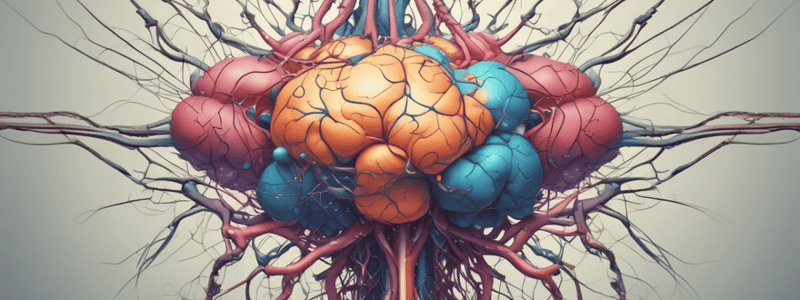Podcast
Questions and Answers
What type of receptor is a muscarinic receptor?
What type of receptor is a muscarinic receptor?
- Dopaminergic receptor
- Adrenergic receptor
- GABA receptor
- Acetylcholine receptor (correct)
Where are muscarinic receptors found?
Where are muscarinic receptors found?
- In both the peripheral and central nervous systems (correct)
- Only in the central nervous system
- Only in muscles
- Only in the peripheral nervous system
What is the effect of M2 and M4 muscarinic receptor subtypes?
What is the effect of M2 and M4 muscarinic receptor subtypes?
- Increase in inositol trisphosphate and calcium
- No effect on second messengers
- Decrease in cAMP (correct)
- Increase in cAMP
What is a function of muscarinic receptors?
What is a function of muscarinic receptors?
What is the effect of a muscarinic receptor agonist?
What is the effect of a muscarinic receptor agonist?
Which disease is targeted by medications that act on muscarinic receptors?
Which disease is targeted by medications that act on muscarinic receptors?
What is the product of phospholipase C hydrolysis of phosphatidylinositol 4,5-bisphosphate?
What is the product of phospholipase C hydrolysis of phosphatidylinositol 4,5-bisphosphate?
What is the role of the βγ subunits in the Gq protein pathway?
What is the role of the βγ subunits in the Gq protein pathway?
What is the effect of muscarinic receptor activation on cyclic adenosine monophosphate (cAMP) production?
What is the effect of muscarinic receptor activation on cyclic adenosine monophosphate (cAMP) production?
What is the downstream effect of diacylglycerol (DAG) activation?
What is the downstream effect of diacylglycerol (DAG) activation?
What is the role of inositol 1,4,5-trisphosphate (IP3) in phospholipase C activation?
What is the role of inositol 1,4,5-trisphosphate (IP3) in phospholipase C activation?
What is the effect of muscarinic receptor inhibition of cAMP production on gene expression?
What is the effect of muscarinic receptor inhibition of cAMP production on gene expression?
What is the function of Gq proteins in the muscarinic receptor pathway?
What is the function of Gq proteins in the muscarinic receptor pathway?
What is the role of CREB in response to changes in cAMP levels?
What is the role of CREB in response to changes in cAMP levels?
Flashcards are hidden until you start studying
Study Notes
Muscarinic Receptors
Overview
- Muscarinic receptors are a type of acetylcholine receptor
- Found in the peripheral nervous system (PNS) and central nervous system (CNS)
- Mediate the effects of acetylcholine, a neurotransmitter
Subtypes
- Five subtypes: M1, M2, M3, M4, and M5
- Each subtype has distinct pharmacological and functional properties
- M1, M3, and M5 are Gq-coupled, leading to increases in inositol trisphosphate and calcium
- M2 and M4 are Gi-coupled, leading to decreases in cAMP
Functions
- Regulate various physiological processes, including:
- Heart rate and contractility
- Smooth muscle contraction and relaxation
- Exocrine gland secretion
- Cognitive function and memory
- Neurotransmitter release
Agonists and Antagonists
- Agonists: stimulate muscarinic receptors, mimicking the effects of acetylcholine
- Examples: muscarine, pilocarpine, andbethanechol
- Antagonists: block the action of acetylcholine on muscarinic receptors
- Examples: atropine, scopolamine, and tolterodine
Clinical Significance
- Muscarinic receptors are involved in various diseases and disorders, including:
- Alzheimer's disease
- Parkinson's disease
- Myasthenia gravis
- Overactive bladder
- Glaucoma
- Targeted by medications for treatment of these conditions
Muscarinic Receptors
Overview
- Muscarinic receptors are a type of acetylcholine receptor found in both the peripheral nervous system (PNS) and central nervous system (CNS).
- They mediate the effects of acetylcholine, a neurotransmitter.
Subtypes
- There are five subtypes of muscarinic receptors: M1, M2, M3, M4, and M5.
- Each subtype has distinct pharmacological and functional properties.
- M1, M3, and M5 subtypes are Gq-coupled, leading to increases in inositol trisphosphate and calcium.
- M2 and M4 subtypes are Gi-coupled, leading to decreases in cAMP.
Functions
- Muscarinic receptors regulate various physiological processes, including:
- Heart rate and contractility
- Smooth muscle contraction and relaxation
- Exocrine gland secretion
- Cognitive function and memory
- Neurotransmitter release
Agonists and Antagonists
- Agonists stimulate muscarinic receptors, mimicking the effects of acetylcholine.
- Examples of agonists include muscarine, pilocarpine, and bethanechol.
- Antagonists block the action of acetylcholine on muscarinic receptors.
- Examples of antagonists include atropine, scopolamine, and tolterodine.
Clinical Significance
- Muscarinic receptors are involved in various diseases and disorders, including:
- Alzheimer's disease
- Parkinson's disease
- Myasthenia gravis
- Overactive bladder
- Glaucoma
- Muscarinic receptors are targeted by medications for the treatment of these conditions.
Muscarinic Receptors
Phospholipase C Activation
- Phospholipase C (PLC) is activated through the Gq protein pathway when muscarinic receptors bind to agonists
- PLC hydrolyzes phosphatidylinositol 4,5-bisphosphate (PIP2) to generate inositol 1,4,5-trisphosphate (IP3) and diacylglycerol (DAG)
- IP3 binds to IP3 receptors on the endoplasmic reticulum, releasing calcium ions from the ER into the cytosol
- DAG activates protein kinase C (PKC), which phosphorylates and activates various downstream targets
Gq Protein Pathway
- Muscarinic receptors are coupled to Gq proteins, which are heterotrimeric G proteins composed of α, β, and γ subunits
- Activated Gq proteins release the βγ subunits, which interact with PLC to activate it
- Gq proteins are responsible for activating PLC when muscarinic receptors are stimulated
cAMP Response Element
- Muscarinic receptors can also inhibit the production of cyclic adenosine monophosphate (cAMP) through the Gi protein pathway
- cAMP is a second messenger that activates protein kinase A (PKA), which phosphorylates and activates the cAMP response element-binding protein (CREB)
- CREB is a transcription factor that regulates gene expression in response to changes in cAMP levels
- Muscarinic receptor-mediated inhibition of cAMP production leads to decreased CREB activity and altered gene expression
Studying That Suits You
Use AI to generate personalized quizzes and flashcards to suit your learning preferences.




